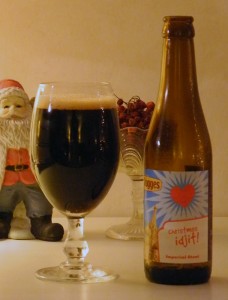![BronxengBrewery_131213_0067]()
![BronxengBrewery_131213_0070 copy]()
Most of us get our beers stopping by our neighborhood bottle shop on the way home from work or when we’re out shopping. We collect whatever commercial beers the proprietor has to offer us and scooch on home to enjoy the catch. Fine. However, there’s a small percentage of the beer drinking population that go in the opposite direction and create their very own unique beers. These are the home brewers.
![BronxengBrewery_131213_0089]()
The reasons for brewing beer in your home are probably as many there are homebrewers out there. Some want to be able keep costs down, some have it as a hobby seeing the beer itself as a nice little by-product and some simply don’t see commercial beer pushing the limits of what beer can achieve. Anton has all of the above, but more importantly he’s found a passion. This is his and dad’s story. This is Bronxeng Brewery.
« I almost do not want to call this a beer… »
![BronxengBrewery_131213_0031]()
Teaming up with his father Sven, the two make up the core of Bronxeng. Both living in the residential area of Brunnsäng, just a stones throw outside of Södertälje, the brewery name being a deliberate mistranslation.
![BronxengBrewery_131213_0004]()
![BronxengBrewery_131213_0006]()
![BronxengBrewery_131213_0020]()
![BronxengBrewery_131213_0015]()
![BronxengBrewery_131213_0022]()
Most of the brewing goes on at Sven’s townhouse home. As I climb the stairs to the second floor I encounter both Anton and Sven busy preparing today’s activities. Just by glancing at them I notice a balance and perfect routine between the two as Anton finishes measuring the grain bill and Sven sanitizes the remaining bottles.
When and how did you guys start your journey down homebrewing lane?
We began doing Coopers DIY-kits back in 2010, rather early in we began experimenting in a uninhibited manner. It perhaps never lead to the greatest of results, but it was a healthy thing being able to let one’s imagination run completely free at that point.
![BronxengBrewery_131213_0008]()
Ok, so where are you at today? What has changed over the years?
Today we’re all-grain brewing on a 20 liter Braumeister machine. Being more than 50 sessions into brewing has changed the way I add new elements to a beer. Now I include experimentation in the planing phase rather than letting it be a part of an ongoing brewing session.
« This year has been insane, I think we’re averaging a little more than two beers a month. »
Perhaps not a question with one simple answer, but one that still has to be dropped. Which beer have you been most content with so far?
My best projects and results lie ahead in time. Push me up against the wall and I’ll have to say Pärlan. It’s a modern pale ale fermented with a Germen Kölsch strain. Loads of El Dorado hops bring on a huge aroma of grape and ripe stonefruit. Sven, noddingly agrees to this.
![BronxengBrewery_131213_0058]()
What challenges do you see as a home brewer?
Well, I usually have a pretty clear idea about what the beer I’m about to brew should convey. Having the beer live up to those expectations is the hard part.
Another issue is that of a more practical nature. Earlier this year we had an infectious outbreak of brettanomyces contaminating our equipment and consequently other beers not fermented with this particular yeast. The brett is under controll nowadays and we’ve got a set of new routines to thank for this. Those routines include cleaning, scrubbing, rinsing, sanitizing over and over again.
![BronxengBrewery_131213_double_02]()
![BronxengBrewery_131213_0083]()
![BronxengBrewery_131213_0045]()
During our interview Anton is simultaneously brewing, racking, dry-hopping as well as bottling a batch of ale. He has a focus and determination and goes about everything like a skilled professional.
Obviously you’ve got the hang of it now. How often do you brew?
This year has been insane, I think we’re averaging a little more than two beers a month. Planning, constantly taking notes and meticulous execution is how we manage. At any given moment we have somewhere in the neighborhood of six fermenters turning wort into beer located somewhere in the house.
![BronxengBrewery_131213_0086]()
When not working directly on the beer itself Anton has to pay attention to details like yeast cultivation or soaking oak in Calvados. These French oak cubes have been lying in liquor since early 2012 and are about to go into an imperial stout known as And one for the Doctor. Anton estimates about a cube and a half of oak per liter beer in order to get the balance of flavor he seeks.
« Earlier this year we had an infectious outbreak of brettanomyces… »
![BronxengBrewery_131213_0080]()
![BronxengBrewery_131213_double_01]()
The great thing about hanging out with a brewer is that you get to sample beer at different stages of the process. A unique opportunity to learn more about what things have an impact on the beer. On my day of visit we had; two month in the fermenter old ale Old Gregg, pre-dryhopped pale ale Pariscade, racked and about-to-be oak aged imperial stout And one for the Doctor and finally the finished product, The Continental.
![BronxengBrewery_131213_0092]()
The Continental is a super smooth yet spritzy brettanomyces fermented beer clocking in a well-disguised 10% ABV. I almost do not want to call this a beer, Anton reflecting notes as we try a first sip. I do both agree and disagree on this. Call it what ever you like, but it’s a damn fine drink. The champagne yeast used in the process lends a sensational effervescent character.
With the enjoyment of yet another fabulous Bronxeng homebrew we come full cirle on this story. It’s now time for Anton to go back to drawing board and do what he likes best, dream up another recipe, yet another beer.
Stay updated on Anton and Sven’s most recent beer adventures via their blog valbalanserad.se (Swedish Only).































